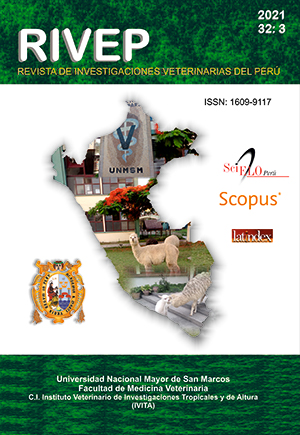Evaluation of stool diagnosis techniques for Toxocara canis
DOI:
https://doi.org/10.15381/rivep.v32i3.18861Keywords:
toxocariasis, zoonoses , public health, nematode, endoparasite, neglected diseasesAbstract
The aim of this study was to evaluate the sensitivity of four coprodiagnostic techniques to quantitatively determine the presence of Toxocara canis eggs in fresh canine stool samples. For this, eggs were extracted from the uterus of adult female T. canis obtained from canine puppies. Eight concentrations of eggs were used (10, 50, 75, 100, 250, 500, 750 and 1 000 eggs per gram of faeces - hpg), being considered as the gold standard to determine the degree of precision of the Kato-Katz, McMaster, Improved Modified McMaster and Faust techniques. Three repetitions were used per technique and per concentration. The sensitivity of each test was performed by arithmetic calculation and ROC curve (95% CI), comparing them with the gold standard by means of a nonparametric test of the Wilcoxon signed ranges (p<0.05). The Faust technique detected T. canis eggs regardless of concentration, but in statistical inequality with the gold standard (p<0.001 to p<0.0001). The Kato-Katz technique did not show significant differences with the gold standard, but it was unable to detect the presence of T. canis eggs in 10 and 50 hpg concentration, while the improved modified McMaster technique showed similarity with the gold standard in 100 and 250 hpg. The McMaster method detected eggs from 100 hpg, obtaining hpg values below the gold standard (p<0.05 and p<0.001). Sensitivities of 74.72% (95% CI 72.93-80.22) were obtained for the Kato-Katz technique and between 30 and 40% (95% CI 26.71-48.29) for the other tests. It is concluded that the Kato-Katz technique obtained a better performance showing a constant quantitative diagnostic sensitivity when compared with other routine quantitative stool diagnosis techniques in veterinary laboratories for T. canis eggs in fresh dog faeces samples.
Downloads
Downloads
Published
Issue
Section
License
Copyright (c) 2021 Jessica Cárdenas Camacho, Karen Isabel Lesmes Infante, Marly Carolina Torres Tocasuche, Neuza Maria Alcantara-Neves, Dumar Alexander Jaramillo Hernández

This work is licensed under a Creative Commons Attribution 4.0 International License.
AUTHORS RETAIN THEIR RIGHTS:
a. Authors retain their trade mark rights and patent, and also on any process or procedure described in the article.
b. Authors retain their right to share, copy, distribute, perform and publicly communicate their article (eg, to place their article in an institutional repository or publish it in a book), with an acknowledgment of its initial publication in the Revista de Investigaciones Veterinarias del Perú (RIVEP).
c. Authors retain theirs right to make a subsequent publication of their work, to use the article or any part thereof (eg a compilation of his papers, lecture notes, thesis, or a book), always indicating the source of publication (the originator of the work, journal, volume, number and date).










